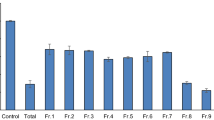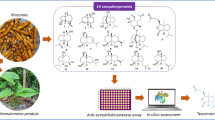Abstract
Alzheimer’s disease is a multi-factorial neurodegenerative disorder devastatingly affecting the aged population worldwide. Previous studies have shown that medicinal herbs used in traditional Chinese medicine might be benefit to Alzheimer’s disease patients. Berberine and palmatine, two isoquinoline alkaloids found in several medicinal herbs, were used for memory enhancement in China. In this study, the inhibitory effects of combined berberine and palmatine on acetylcholinesteras were evaluated using recombinant human acetylcholinesterase. Our results showed that the combination of berberine and palmatine inhibited acetylcholinesterase in a mixed competitive pattern. By the median-effect principle, the calculated combination index of the combination was less than 1, suggesting that berberine and plamatine inhibited acetylcholinesterase synergistically. Furthermore, the drug-reducing index of berberine and palmatine were 2.98 and 2.66, respectively. Taken together, the results showed that the combination of the two alkaloids might potentially be developed as a more effective therapeutic strategy for Alzheimer’s disease patients.
Access this article
We’re sorry, something doesn't seem to be working properly.
Please try refreshing the page. If that doesn't work, please contact support so we can address the problem.




Similar content being viewed by others
References
Ago Y, Koda K, Takuma K, Matsuda T (2011) Pharmacological aspects of the acetylcholinesterase inhibitor galantamine. J Pharmacol Sci 116:6–17
Bestas A, Goksu H, Erhan OL (2013) The effect of preoperative consumption of potatoes on succinylcholine-induced block and recovery from anesthesia. J Clin Monit Comput 27:609–612
Bi CW, Luk WK, Campanari ML et al (2014) Quantification of the transcripts encoding different forms of AChE in various cell types: real-time PCR coupled with standards in revealing the copy number. J Mol Neurosci (in press)
Choi RC, Zhu JT, Yung AW et al (2013) Synergistic action of flavonoids, baicalein, and daidzein in estrogenic and neuroprotective effects: a development of potential health products and therapeutic drugs against Alzheimer’s disease. Evid Based Complement Alternat Med 2013:635694
Chou TC (2010) Drug combination studies and their synergy quantification using the Chou-Talalay method. Cancer Res 70:440–446
Chou TC, Motzer RJ, Tong Y, Bosl GJ (1994) Computerized quantitation of synergism and antagonism of taxol, topotecan, and cisplatin against human teratocarcinoma cell growth: a rational approach to clinical protocol design. J Natl Cancer Inst 86:1517–1524
del Monte-Millan M, Garcia-Palomero E, Valenzuela R et al (2006) Dual binding site acetylcholinesterase inhibitors: potential new disease-modifying agents for AD. J Mol Neurosci 30:85–88
Dogterom P, Nagelkerke JF, Mulder GJ (1988) Hepatotoxicity of tetrahydroaminoacridine in isolated rat hepatocytes: effect of glutathione and vitamin E. Biochem Pharmacol 37:2311–2313
Dong TT, Zhao KJ, Gao QT et al (2006) Chemical and biological assessment of a Chinese herbal decoction containing Radix Astragali and Radix Angelicae Sinensis: determination of drug ratio in having optimized properties. J Agric Food Chem 54:2767–2774
Ellman GL, Courtney KD, Andres Jr V, Feather-Stone RM (1961) A new and rapid colorimetric detemination of acetylcholine activity. Biochem Pharmacol 7:88–95
Gao QT, Cheung JK, Li J et al (2007) A Chinese herbal decoction, Danggui Buxue Tang, activates extracellular signal-regulated kinase in cultured T-lymphocytes. FEBS Lett 581:5087–5093
Han YF, Li CP, Chow E, Wang H, Pang YP, Carlier PR (1999) Dual-site binding of bivalent 4-aminopyridine- and 4-aminoquinoline-based AChE inhibitors: contribution of the hydrophobic alkylene tether to monomer and dimer affinities. Bioorg Med Chem 7:2569–2575
Hopkins TJ, Rupprecht LE, Hayes MR, Blendy JA, Schmidt HD (2012) Galantamine, an acetylcholinesterase inhibitor and positive allosteric modulator of nicotinic acetylcholine receptors, attenuates nicotine taking and seeking in rats. Neuropsychopharmacology 37:2310–2321
Huang L, Su T, Li X (2013) Natural products as sources of new lead compounds for the treatment of Alzheimer’s disease. Curr Top Med Chem 13:1864–1878
Imanshahidi M, Hosseinzadeh H (2008) Pharmacological and therapeutic effects of Berberis vulgaris and its active constituent, berberine. Phytother Res 22:999–1012
Konrath EL, Passos Cdos S, Klein LC Jr, Henriques AT (2013) Alkaloids as a source of potential anticholinesterase inhibitors for the treatment of Alzheimer’s disease. J Pharm Pharmacol 65:1701–1725
Kupeli E, Kosar M, Yesilada E, Husnu K, Baser C (2002) A comparative study on the anti-inflammatory, antinociceptive and antipyretic effects of isoquinoline alkaloids from the roots of Turkish Berberis species. Life Sci 72:645–657
Li W, Xue J, Niu C et al (2007) Synergistic neuroprotection by bis(7)-tacrine via concurrent blockade of N-methyl-d-aspartate receptors and neuronal nitric-oxide synthase. Mol Pharmacol 71:1258–1267
Lin HQ, Ho MT, Lau LS, Wong KK, Shaw PC, Wan DC (2008) Anti-acetylcholinesterase activities of traditional Chinese medicine for treating Alzheimer’s disease. Chem Biol Interact 175:352–354
Liu JP, Feng L, Zhang MH et al (2013) Neuroprotective effect of Liuwei Dihuang decoction on cognition deficits of diabetic encephalopathy in streptozotocin-induced diabetic rat. J Ethnopharmacol 150:371–381
Luk WK, Chen VP, Choi RC, Tsim KW (2012) N-linked glycosylation of dimeric acetylcholinesterase in erythrocytes is essential for enzyme maturation and membrane targeting. Febs J 279:3229–3239
Murray AP, Faraoni MB, Castro MJ, Alza NP, Cavallaro V (2013) Natural AChE inhibitors from plants and their contribution to Alzheimer’s disease therapy. Curr Neuropharmacol 11:388–413
Ohnishi T, Sakiyama Y, Okuri Y et al (2013) The prediction of response to galantamine treatment in patients with mild to moderate Alzheimer’s disease. Curr Alzheimer Res (in press)
Preissner S, Dunkel M, Hoffmann MF et al (2012) Drug cocktail optimization in chemotherapy of cancer. PLoS One 7:e51020
Schwarz M, Glick D, Loewenstein Y, Soreq H (1995) Engineering of human cholinesterases explains and predicts diverse consequences of administration of various drugs and poisons. Pharmacol Ther 67:283–322
Sun ZK, Yang HQ, Chen SD (2013) Traditional Chinese medicine: a promising candidate for the treatment of Alzheimer’s disease. Transl Neurodegener 2:6
Williams TL, Serpell LC (2011) Membrane and surface interactions of Alzheimer’s Aβ peptide—insights into the mechanism of cytotoxicity. FEBS J 278:3905–3917
Xiao HT, Peng J, Liang Y et al (2011) Acetylcholinesterase inhibitors from Corydalis yanhusuo. Nat Prod Res 25:1418–1422
Ye M, Fu S, Pi R, He F (2009) Neuropharmacological and pharmacokinetic properties of berberine: a review of recent research. J Pharm Pharmacol 61:831–837
Yi J, Ye X, Wang D et al (2013) Safety evaluation of main alkaloids from Rhizoma Coptidis. J Ethnopharmacol 145:303–310
Zhao LN, Long H, Mu Y, Chew LY (2012) The toxicity of amyloid β oligomers. Int J Mol Sci 13:7303–7327
Acknowledgments
This work was supported by grants from the Hong Kong Research Grants Council Theme-based Research Scheme (T13-607/12R), GRF (661110, 662911, 660411, 663012, 662713), TUYF12SC03, The Hong Kong Jockey Club Charities Trust and Foundation of The Awareness of Nature (TAON12SC01) to Karl Tsim. Research Grants Council of Hong Kong (PolyU5609/09 M and PolyU5610/11 M), The Hong Kong Polytechnic University (G-YM32, G-YZ15 and G-UC15), and the National Natural Science Foundation of China (81202510) to Yifan HAN.
Author information
Authors and Affiliations
Corresponding author
Rights and permissions
About this article
Cite this article
Mak, S., Luk, W.W.K., Cui, W. et al. Synergistic Inhibition on Acetylcholinesterase by the Combination of Berberine and Palmatine Originally Isolated from Chinese Medicinal Herbs. J Mol Neurosci 53, 511–516 (2014). https://doi.org/10.1007/s12031-014-0288-5
Received:
Accepted:
Published:
Issue Date:
DOI: https://doi.org/10.1007/s12031-014-0288-5




